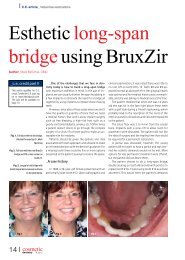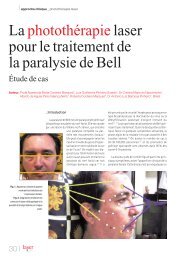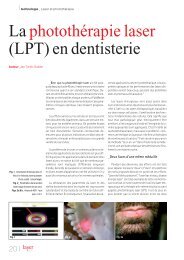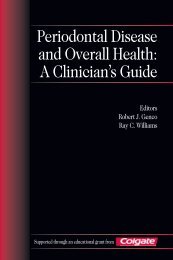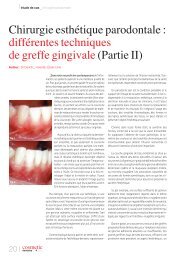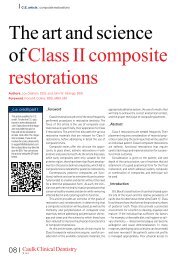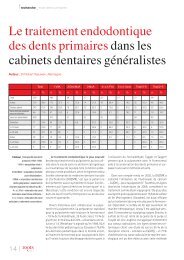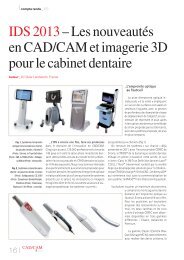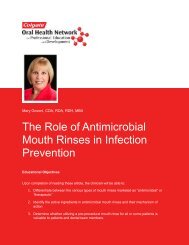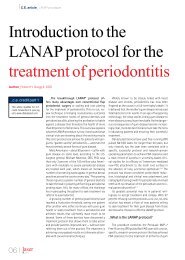Periodontal Disease and Overall Health: A Clinician's Guide
Periodontal Disease and Overall Health: A Clinician's Guide
Periodontal Disease and Overall Health: A Clinician's Guide
You also want an ePaper? Increase the reach of your titles
YUMPU automatically turns print PDFs into web optimized ePapers that Google loves.
CHAPTER 2Overview of <strong>Periodontal</strong> <strong>Disease</strong>:Causes, Pathogenesis, <strong>and</strong>CharacteristicsYing Gu, Maria E. RyanINTRODUCTION<strong>Periodontal</strong> diseases are serious chronicinfections that involve destruction of thetooth-supporting apparatus, including thegingiva, the periodontal ligament, <strong>and</strong> alveolarbone. These diseases are initiated by alocal accumulation of bacteria adjacent tothe tooth. <strong>Periodontal</strong> diseases, includinggingivitis <strong>and</strong> periodontitis, can affect onetooth or many teeth <strong>and</strong>, if left untreated,can lead to tooth loss, particularly in adults.It is the most common dental condition inadults, <strong>and</strong> is also one of the most commonchronic inflammatory diseases affecting amajority of the population throughout theworld. Although plaque is essential for theinitiation of periodontal diseases, the majorityof the destructive processes associatedwith these diseases are due to an excessivehost response to the bacterial challenge.Therefore, periodontal disease is a multifactorial,complex disease. The purpose of thischapter is to provide a general overview ofthe types of periodontal disease, risk factorsassociated with them, <strong>and</strong> the etiology,pathogenesis, <strong>and</strong> management of periodontaldiseases.TYPES OF PERIODONTAL DISEASE<strong>Periodontal</strong> diseases include two generalcategories based on whether there is attachmentor bone loss: gingivitis <strong>and</strong> periodontitis.Gingivitis is considered a reversibleform of the disease, <strong>and</strong> generally involvesinflammation of the gingival tissues withoutloss of connective tissue attachment. 1Periodontitis has been defined as the presenceof gingival inflammation at sites wherethere has been a pathological detachment ofcollagen fibers from cementum, the junctionalepithelium has migrated apically, <strong>and</strong>bone loss can be detected radiographically.The inflammatory events associated withconnective tissue attachment loss lead tothe resorption of coronal portions of toothsupporting alveolar bone. 2 The underst<strong>and</strong>ingof periodontal disease is continuouslychanging as new research evidence emerges.There fore, the classification of periodontaldisease has changed since the system developedat the 1989 World Workshop in ClinicalPeriodontics. The classification presentedin this chapter is based on the results developedat the 1999 International Workshop organizedby the American Academy of Perio -dontology (AAP).The classification of periodontal diseasesnow includes eight general types 3 :1. Gingivitis2. Chronic periodontitis3. Aggressive periodontitis4. Periodontitis as a manifestation ofsystemic diseases5. Necrotizing periodontal diseases6. Abscesses of the periodontium7. Periodontitis associated with endo -dontic lesions8. Developmental or acquired deformities<strong>and</strong> conditionsThe overall classification system ispresented in Table 1. 3 In addition, the aboveclassification is different from case types



